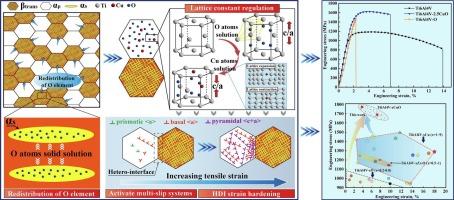Achieving high oxygen tolerance in Ti6Al4V: Copper-oxygen co-doping strategy for ultrahigh strength-ductility balance
IF 7.9
2区 材料科学
Q1 MATERIALS SCIENCE, MULTIDISCIPLINARY
引用次数: 0
Abstract
Conventional α + β Ti6Al4V alloys lack sufficient strengthening mechanisms, limiting strength. While oxygen (O) offers a cost-effective strengthening route, exceeding ∼ 0.33 wt% causes significant embrittlement. Here, we explored how to efficiently utilize interstitial oxygen to enhance the mechanical properties of Ti6Al4V. The copper oxide (CuO) was innovatively employed as a precursor to completely dissolve into Ti6Al4V matrix, interstitial O and substitutional Cu atoms were simultaneously utilized to strengthen the primary α-phase (αp) while inducing the abundant secondary-α (αs) nanoprecipitates. Surprisingly, the introduction of Cu element facilitated control of lattice distortion and redistributed oxygen between αp and β-transformed (βtrans) structure, resulting in the Ti6Al4V-2.5CuO (wt.%) alloy with high oxygen tolerance (0.62 wt%) and an ultra-high ultimate strength of ∼ 1635 MPa and a favorable ductility of ∼ 5.3 %. The dual effect of interstitial solid solution strengthening and αs precipitation strengthening were achieved under the Cu/O interaction. Additionally, the addition of Cu promoted the oxygen redistribution and activation of the basal < a > and pyramidal < c + a > slip systems, thereby ensuring improved ductility. This study presented a novel strategy for high-strength Ti alloys using interstitial oxygen, maximizing strengthening while mitigating embrittlement.

在Ti6Al4V:铜氧共掺杂策略中实现超高强度-塑性平衡的高氧耐受性
传统的α + β Ti6Al4V合金缺乏足够的强化机制,限制了强度。虽然氧(O)提供了一种经济有效的强化途径,但超过0.33 wt%会导致明显的脆化。本文探讨了如何有效地利用间隙氧来提高Ti6Al4V的力学性能。创新地采用氧化铜(CuO)作为前驱体完全溶解于Ti6Al4V基体中,同时利用间隙O和取代Cu原子强化初生α-相(αp),同时诱导丰富的次生α (αs)纳米沉淀。令人惊讶的是,Cu元素的引入促进了αp和β-转化(β反式)结构之间晶格畸变的控制和氧的再分配,从而使Ti6Al4V-2.5CuO (wt.%)合金具有高氧耐受性(0.62 wt%)、超高的极限强度(~ 1635 MPa)和良好的延展性(~ 5.3%)。Cu/O相互作用实现了间隙固溶体强化和αs析出强化的双重作用。此外,Cu的加入促进了基型<; a >;和锥体<; c + a >;滑移体系的氧再分配和活化,从而确保了延展性的提高。本研究提出了一种使用间隙氧的高强度钛合金的新策略,在最大限度地增强的同时减轻脆化。
本文章由计算机程序翻译,如有差异,请以英文原文为准。
求助全文
约1分钟内获得全文
求助全文
来源期刊

Materials & Design
Engineering-Mechanical Engineering
CiteScore
14.30
自引率
7.10%
发文量
1028
审稿时长
85 days
期刊介绍:
Materials and Design is a multi-disciplinary journal that publishes original research reports, review articles, and express communications. The journal focuses on studying the structure and properties of inorganic and organic materials, advancements in synthesis, processing, characterization, and testing, the design of materials and engineering systems, and their applications in technology. It aims to bring together various aspects of materials science, engineering, physics, and chemistry.
The journal explores themes ranging from materials to design and aims to reveal the connections between natural and artificial materials, as well as experiment and modeling. Manuscripts submitted to Materials and Design should contain elements of discovery and surprise, as they often contribute new insights into the architecture and function of matter.
 求助内容:
求助内容: 应助结果提醒方式:
应助结果提醒方式:


